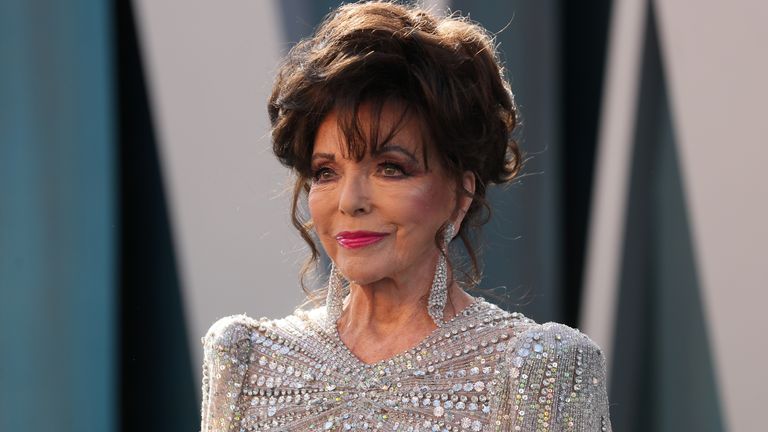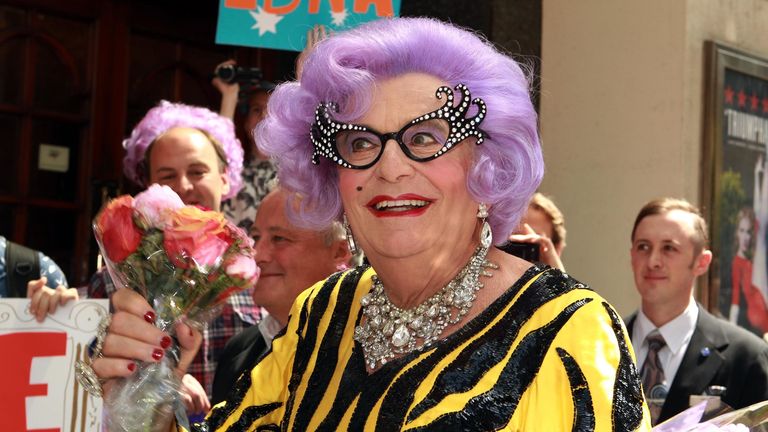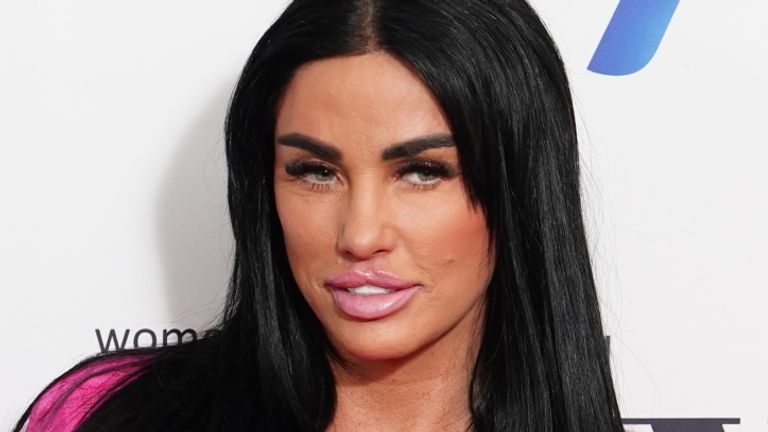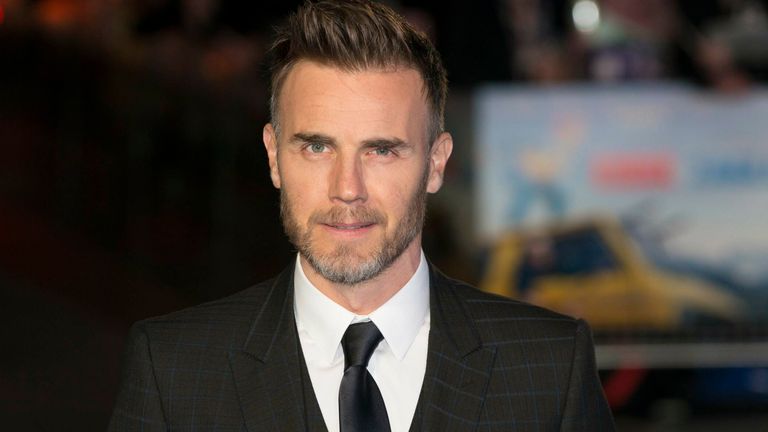Lynn Barber has seen the lot. Across six decades as a celebrity interviewer, she’s navigated a death threat*, a stand-off with a star best known for playing an amiable TV doctor and a wild animal at the dinner table.
Now, a sticky conversation with Joan Collins and a run-in with the actress’s “dragon” PR has led Barber to a stark showbiz realisation.
Barber tells Sky News: “I’m not up for celebrity interviews any more.”
She goes on: “I’ve turned down a lot of ideas I’ve been sent. It was rare for me to agree to do Joan Collins, and it was only because Tracey [Emin] said we’d get on so well, and then we didn’t.”
Emin’s premonition that Barber and Collins would “get on like a house on fire”, failed to produce the anticipated warm reception.
Barber explains: “[Joan] had this dragon PR with her. I asked my first question – something about turning 90 as she was just writing a book about just that – and the PR said: ‘You can’t ask about her age’.
“I thought, this is just madness. I was in a foul temper, and I thought, I can’t do this anymore.”
Dubbing interview requests “to plug a specific something or other” as “just a bore”, Barber says a “very sticky conversation” with Collins ensued, with “people saying things like, ‘Why don’t you ask about [Joan’s] beauty routine?’.
Barber says she later called her editor “practically in tears” telling them “I can’t write it. I can’t face writing it”.
True to her word, no interview with Collins has ever seen the light of day.
The Demon Barber of Fleet Street
The world of celebrity interviews has changed over the years – and not for the better. There are shorter time slots with talent, ever-present PRs and strict rules about what can and cannot be asked.
Barber, who has just turned 80 and is ever the rule breaker, simply isn’t having it. “When you’re young, you have to do what you’re told. But I don’t.”
Dubbed the Demon Barber of Fleet Street at the height of writing fame, it was a nickname Barber didn’t mind but also didn’t agree with.
“I had a reputation as a hatchet woman. If I look back on my cutting books, I didn’t do that many hatchet jobs, but they were the ones that people remembered.”
She’s right – Marianne Faithful, Martin Clunes and Meat Loaf – all came out of their verbal sparring session with Barber the worse off, and they are among her most memorable interviews.
Barber’s sex may have had much to do with the public reaction to her probing questions.
She explains, “Some people thought it was extraordinary that a woman can be rude to somebody”.
Her perceived rudeness comes from a tenacious ability to hone in on her story at all costs – as the New York Times so neatly summarised: “Ms Barber’s interviews are prized because of her ability to seize on a telling detail, and to not let go even if clubbed with a stick.”
‘Star f***** pieces’
The saviour of the celebrity interview, Barber single-handedly reinvented a genre that tended to flatter and fawn, blowing it apart by asking questions less ballsy journalists would quake at.
Asking Jimmy Savile if it was true he “liked little girls” in 1990, Barber was the first to acknowledge the rumours in print. Over 20 years later police named the disgraced DJ as one of Britain’s most prolific sex offenders.
Interviewing the stars was a role Barber made entirely her own, partly due to the fact she says, “There weren’t such things as celebrity interviews when I started in journalism”.
Worse than that, the celebrity interviews she was first tasked with writing were referred to as “star f***** pieces”. Barber says “I showed that they didn’t have to be star f***** pieces, that they could be interviews”.
With her content elevated from fluffy filler to front-page news, she showed it in bucket loads.
While Barber says she’s not “unimpressed by fame” she says did have to get over “the star-struck thing” early in her career, in a bid to get the best possible interviews. She’s gone on to interview at least 1000 subjects.
Barber admits: “Once or twice subsequently, I have felt starstruck, you know, and it’s not a good thing. It’s not helpful.”
The Turner Prize is ‘nonsense’
Her many years grilling actors, pop stars and artists have given her the ability to sum up character in the blink of an eye.
Actors? “Timid people pleasers” who “want to say what you want them to say”.
Pop stars? They’re “brave” because they “get out in front of people and expose themselves to other people’s opinions”. But that’s only the “proper” ones who “write their own material”.
And artists? “They don’t babble away the way actors do… They’re not the flashiest of subjects, but I find it very rewarding interviewing them”. Perhaps most importantly… “They throw good parties”.
And it’s her love of artists and their work that has inspired her latest book, A Little Art Education.
Playing on the title of her 2009 memoir, An Education, about her schoolgirl affair with a conman, which was made into a film starring Carey Mulligan, it documents her lifelong love of art and her interviews with some of the world’s leading artists.
An apparent cherry on the cake – when Barber was selected as a Turner Prize judge in 2006 – turned out to be a flop. Barber describes the drawn-out process of assessing the work in the run-up to the event as “a drag” and the prestigious awards as “nonsense”.
Going further back, to the beginnings of her love of art (despite claiming to have “no talent whatsoever” for creating it herself), Barber compares her expulsion from the art room as a teenager after failing her art GCSE as being “kicked out of paradise”.
But years later, after finding success as a journalist, that Barber saw her way back in.
Bring your big cat to tea
“Having made a name as an interviewer of general celebrities, I thought ‘Well who do I really like interviewing?’ And most of all I like interviewing artists, and some of them became friends, most of all Tracey Emin”.
Emin’s artwork is hung in Barber’s hallway, and a letter from artist Lucian Freud is framed on the wall in the downstairs toilet (he’s rejecting her request to interview him, an offer he likens to “being shat on by a stranger”).
Meanwhile, Barber’s six Press Awards – won across four decades – are lined up along the floor, a fitting tribute to her lack of ego (and available wall space).
The most dramatic moment of Barber’s career came early she says, when interviewing Spanish surrealist Salvador Dali for Penthouse.
Stretched across three days while holed up in a luxury Paris hotel, she describes the encounter – which included taking the artist’s ocelot (a medium-sized spotted wild cat) to lunch in the hotel restaurant – as “bliss”.
She was also propositioned by his secretary, Captain Moore, who invited Barber to join him and his fiancée for a threesome, but ever the professional, Barber declined.
In fact, despite working for a men’s magazine, Barber says she was rarely propositioned on the job – barring “one footballer I seem to remember in the 1960s”. Barber doesn’t remember his name – or is too discreet to mention it.
But the power dynamic of a young, female reporter interviewing older men is not lost on Barber.
“I think the way editors saw it, was send a pretty girl to do the interview, and then they’ll be butter in her hands.”
‘Regret’ for Rupert Everett’s ‘wasted time’
Regardless, Barber was of the opinion that “taking an interest in someone is far better than looking provocative”, and despite it being “terrific fun” to work at the men’s magazine, she says it was ultimately without a future because “in those days when you got pregnant, you left [work]”.
But after seven years there, followed by time off to have and bring up two daughters, it was an out-of-the-blue commission that drew Barber back into the media world.
A former Penthouse colleague, who had moved to the Telegraph, commissioned her to interview famed Austrian ethologist Konrad Lorenz in Vienna.
Barber didn’t think twice: “After years of Finsbury Park playgroup to be sent to Vienna, put up in a nice hotel, sent to interview someone who’s absolutely riveting. I thought interviewing’s a really good thing.”
Moving to the Sunday Express magazine in the 1980s, she went on to interview the great and the good across the decades that followed – Roald Dahl, Barry Manilow, John Paul Getty Jr (one of the richest men in the world at the time) and Calvin Klein.
She describes interviewing ballet dancer Rudolf Nureyev on a lake in Italy towards the end of his career.
“It was just incredibly moving. And I think, in retrospect, he was trying to tell me he’d got AIDS, and I was just sort of not picking it up, you know, lots of hints about how he had to keep dancing. I can’t think how I was so obtuse.”
Of Barry Humphries, AKA Dame Edna Everage, she says he was “mad” and “weird” but gave great art advice, telling her he’d “stopped buying art by dead people” because he “didn’t like to think of the money going to dealers or auctioneers”.
Only one actor defied her general experience that actors are bores. “I liked Rupert Everett very much, he’s witty and a brilliant writer… But I regret that he wasted time acting when he could be writing wonderful books.”
Mostly Men
And then there were the sit-downs with stars who almost interviewed themselves. She passes on all credit for her “sparkling interview” with Irish actor Richard Harris to the man himself. “It wasn’t me… You could have sent a monkey with a tape recorder.”
Barber’s 1991 book of interviews is titled Mostly Men, in honour of the majority of male interviewees it features (28 out of 34). Her second collection, 2008’s Demon Barber, is similarly skewed with 26 men out of 30 interviewees.
Barber explains: “In those days, there seem to be many more men that were being put up for interview.”
Did the gender divide affect her approach? Barber says: “I think I did, certainly at the beginning, interview men better than women. I’m always a bit inhibited with women. I sort of slightly hold back with them.”
Was it a sisterhood thing? “No!” Barber laughs. But it could be offspring-related.
“When I started doing lots of celebrity interviews in the 80s and 90s, I still had children at home. And so always in the back of my mind is thinking about their children reading it.”
Now, with her own children all grown up, Barber says there are different ‘no go’ areas.
“I did a fairly good interview quite recently with, Liz Hurley for Tatler. That wasn’t bad. But now, it’s very difficult with women commenting on their appearance at all.”
She adds: “I suppose I feel a bit more combative with men.”
‘My father used to shout the whole time’
It’s a stance that could stem from childhood experience – and which also could explain Barber’s unrelenting tenacity.
“I think I’m fairly fearless by nature. My father used to shout the whole time. So, I’m not scared of people shouting at me. And it’s quite funny because I think [people] look at me and think that I’m a sweet old thing, but I’m not.”
While single-handedly shifting the dial on celebrity interviews in the UK back in the 1980s, Barber acknowledges the landscape of celebrity interviews is again in flux, with modern technology, social media and the creation of reality TV stars all feeding into the changes.
While the advent of reality TV didn’t get into full swing until after Barber’s heyday, she did interview Katie Price (who she says she “got on very well with” and was “impressed by”) as well as Kerry Katona.
Never one to openly pre-judge her subject, Barber explains: “That’s what makes it interesting. You go along expecting that somebody will be an airhead or something, and then they’re great.
“Or you go along thinking that you’ll be charmed… I had a nasty stand-off with Martin Clunes, for instance, who I admired and then didn’t. But that’s why it’s worth doing.”
‘Wicked’ PRs
Modern technology also means that interviewers can be beaten to the punch on their own scoop.
Barber says: “I went to interview Gary Barlow, and there was a PR in the room who was recording the interview. And then started putting bits of, as it were, my content out on social media before I’d written it.”
She labels the PR’s actions “wicked”.
Despite being one of the world’s greatest interviewers, even Barber wasn’t able to elicit an interesting response from the Take That star.
As for social media, Barber says: “If I were a celebrity who had opinions I wanted to get out, I would do it on social media, not through the press.”
She adds: “Interviewing is in a bit of a trough at the moment. And I’m not quite sure what the answer is.”
So, is there really no celebrity she’d still love to sit down with?
At a push, Barber agrees she might consider interviewing Carey Mulligan, who played her in the movie of her memoir, and with whose parents Barber spent much time at subsequent awards ceremonies.
But Barber’s current consuming passion is the pub quiz – although she insists, she’s “pretty hopeless”.
And as for who she’d invite to her dream dinner party, her answer flashes the only sign of bluntness in our encounter.
“I hate dinner parties. There would be no guests. I don’t even eat dinner.”
And there it is – the no-nonsense approach you’d expect from the Demon Barber.
Disillusioned with celebrity journalism maybe, but certainly not out.
A Little Art Education is available now.
*The death threat was from the Chapman Brothers – Jake and Dinos – who following the publication of Barber’s interview with them in 2006 said they would kill her if they ever saw her again.
To avoid the possibility, Barber “kept out of [Jake’s] way” despite sometimes seeing them at parties. Hatchets have since been buried.










